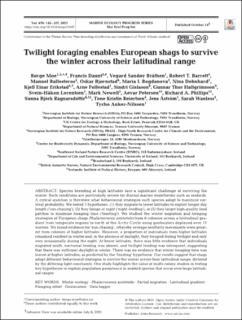| dc.contributor.author | Moe, Børge | |
| dc.contributor.author | Daunt, Francis | |
| dc.contributor.author | Bråthen, Vegard Sandøy | |
| dc.contributor.author | Barrett, Robert | |
| dc.contributor.author | Ballesteros, Manuel | |
| dc.contributor.author | Bjørnstad, Oskar | |
| dc.contributor.author | Bogdanova, Maria I. | |
| dc.contributor.author | Dehnhard, Nina | |
| dc.contributor.author | Erikstad, Kjell E. | |
| dc.contributor.author | Follestad, Arne | |
| dc.contributor.author | Gíslason, Sindri | |
| dc.contributor.author | Hallgrimsson, Gunnar Thor | |
| dc.contributor.author | Lorentsen, Svein-Håkon | |
| dc.contributor.author | Newell, Mark | |
| dc.contributor.author | Petersen, Aevar | |
| dc.contributor.author | Phillips, Richard A. | |
| dc.contributor.author | Ragnarsdóttir, Sunna Björk | |
| dc.contributor.author | Reiertsen, Tone Kristin | |
| dc.contributor.author | Åström, Jens | |
| dc.contributor.author | Wanless, Sarah | |
| dc.contributor.author | Anker-Nilssen, Tycho | |
| dc.date.accessioned | 2021-11-16T09:25:49Z | |
| dc.date.available | 2021-11-16T09:25:49Z | |
| dc.date.created | 2021-11-01T09:10:59Z | |
| dc.date.issued | 2021 | |
| dc.identifier.citation | Marine Ecology Progress Series. 2021, 676 145-157. | en_US |
| dc.identifier.issn | 0171-8630 | |
| dc.identifier.uri | https://hdl.handle.net/11250/2829752 | |
| dc.description.abstract | Species breeding at high latitudes face a significant challenge of surviving the winter. Such conditions are particularly severe for diurnal marine endotherms such as seabirds. A critical question is therefore what behavioural strategies such species adopt to maximise survival probability. We tested 3 hypotheses: (1) they migrate to lower latitudes to exploit longer day length (‘sun-chasing’), (2) they forage at night (‘night-feeding’), or (3) they target high-quality food patches to minimise foraging time (‘feasting’). We studied the winter migration and foraging strategies of European shags Phalacrocorax aristotelis from 6 colonies across a latitudinal gradient from temperate regions to north of the Arctic Circle using geolocators deployed over 11 winters. We found evidence for ‘sun-chasing’, whereby average southerly movements were greatest from colonies at higher latitudes. However, a proportion of individuals from higher latitudes remained resident in winter and, in the absence of daylight, they foraged during twilight and only very occasionally during the night. At lower latitudes, there was little evidence that individuals migrated south, nocturnal feeding was absent, and twilight feeding was infrequent, suggesting that there was sufficient daylight in winter. There was no evidence that winter foraging time was lowest at higher latitudes, as predicted by the ‘feasting’ hypothesis. Our results suggest that shags adopt different behavioural strategies to survive the winter across their latitudinal range, dictated by the differing light constraints. Our study highlights the value of multi-colony studies in testing key hypotheses to explain population persistence in seabird species that occur over large latitudinal ranges. | en_US |
| dc.language.iso | eng | en_US |
| dc.publisher | Inter Research | en_US |
| dc.rights | Navngivelse 4.0 Internasjonal | * |
| dc.rights.uri | http://creativecommons.org/licenses/by/4.0/deed.no | * |
| dc.title | Twilight foraging enables European shags to survive the winter across their latitudinal range | en_US |
| dc.type | Peer reviewed | en_US |
| dc.type | Journal article | en_US |
| dc.description.version | publishedVersion | en_US |
| dc.source.pagenumber | 145-157 | en_US |
| dc.source.volume | 676 | en_US |
| dc.source.journal | Marine Ecology Progress Series | en_US |
| dc.identifier.doi | 10.3354/meps13697 | |
| dc.identifier.cristin | 1950028 | |
| dc.relation.project | Norges forskningsråd: 192141 | en_US |
| dc.relation.project | Framsenteret: 232019 | en_US |
| cristin.ispublished | true | |
| cristin.fulltext | original | |
| cristin.qualitycode | 2 | |

